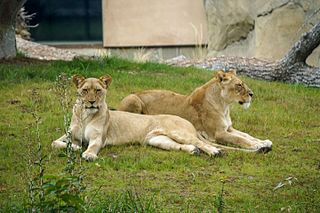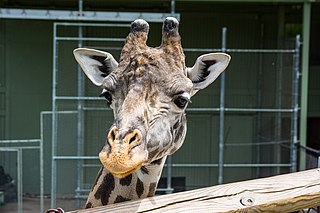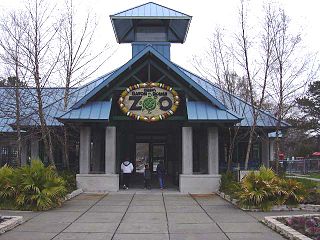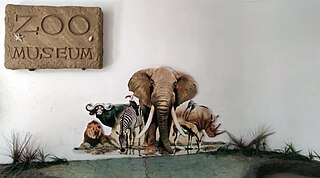
The Houston Zoo is a 55-acre (22 ha) zoological park located within Hermann Park in Houston, Texas, United States. The zoo houses over 6,000 animals from more than 900 species. It receives around 2 million visitors each year and is the second most visited zoo in the United States, surpassed only by the San Diego Zoo. It is accredited by the Association of Zoos and Aquariums (AZA).

Woodland Park Zoo is a wildlife conservation organization and zoological garden located in the Phinney Ridge neighborhood of Seattle, Washington, United States. The zoo is the recipient of over 65 awards across multiple categories. The zoo has around 900 animals from 250 species and the zoo has over 1 million visitors a year.

The Cheyenne Mountain Zoo is a zoological park located southwest of downtown Colorado Springs, Colorado, on Cheyenne Mountain in the United States. At an elevation of 6,714 feet (2,046 m) above sea level, it is the highest zoo in the country. The zoo covers 140 acres (57 ha), 40 of which are in use. The zoo houses more than 750 animals, representing nearly 170 different species, with more than 30 endangered species. The zoo was ranked the #4 best zoo in North America in 2018 by USA Today. It is accredited by the Association of Zoos and Aquariums.

Zoo Atlanta is an Association of Zoos and Aquariums (AZA) accredited zoological park in Atlanta, Georgia. The current president and CEO of Zoo Atlanta is Raymond B. King.

The Little Rock Zoo was founded in 1926 and is located in Little Rock, Arkansas, United States. It is home to more than 725 animals representing over 200 species, and covers an area of 33 acres (13 ha). The Arkansas Zoological Foundation is a private 501 c (3) organization that raises funds for zoo development. The Little Rock Zoo is a department of the city of Little Rock. It is the largest zoo in Arkansas, and the only Arkansas zoo accredited by the Association of Zoos and Aquariums (AZA).

Colchester Zoo is a zoological garden situated near Colchester, England. The zoo opened in 1963 and celebrated its 60th anniversary on 2 June 2023. It is home to many rare and endangered species, including big cats, primates and birds as well as many invertebrates and fish species.

Ragunan Zoo is a zoo located in Pasar Minggu, South Jakarta, Indonesia. The zoo has an area of 140-hectare (350-acre). The zoo has an aviary and a primate centre, and employs over 450 people. Many of the animals in the zoo are endangered and threatened from all parts of Indonesia and the rest of the world. There are a total of 2,288 animals inside the zoo. Laid out in a lush tropical habitat, rare animals such as crocodile, gorilla, orangutan, tapir, anoa, sumatran tiger, babirusa, and peacocks are given ample room. The zoo is located in South Jakarta and is easily accessible through the Jakarta Outer Ring Road and TransJakarta Corridor 6 bus.
The Fort Worth Zoo is a zoo in Fort Worth, Texas, United States, and is home to 7,000 native and exotic animals. It has been named as a top zoo in the nation by Family Life magazine, the Los Angeles Times and USA Today, as well as one of the top zoos in the South by Southern Living Reader's Choice Awards.

The Fresno Chaffee Zoo is a zoo in Roeding Park in Fresno, California covering 39 acres and housing over 190 species. Its attractions include Stingray Bay, Dino Dig, Valley Farm, Sea Lion Cove, African Adventure, and Ross Laird's Winged Wonders Bird Show. The zoo is accredited by the Association of Zoos and Aquariums (AZA) and is a member of the World Association of Zoos and Aquariums (WAZA).

Cameron Park Zoo is a 52-acre (21 ha) natural habitat zoo located within Cameron Park in the city of Waco, Texas, United States, next to the Brazos River. Established in July 1993, Cameron Park Zoo has lush native vegetation that surrounds splashing waterfalls, a picturesque lake, and ponds. And in the midst of all this beauty, visitors see that the wild ones not only survive in their natural habitat, but they also flourish. The zoo features a diverse collection that includes over 1731 animals, representing 300 species from around the world.
The Binder Park Zoo is a 433-acre (175 ha) zoo that opened in 1977 near Battle Creek, Michigan, in the United States. Binder Park Zoo is one of the largest zoos in Michigan, and features a large array of animals and plants, including the Wild Africa Exhibit. It includes a train, a tram, a carousel, and ropes course called "Skylark Ridge".

The American Species Survival Plan or SSP program was developed in 1981 by the (American) Association of Zoos and Aquariums to help ensure the survival of selected species in zoos and aquariums, most of which are threatened or endangered in the wild.

The El Paso Zoo is a zoo located in El Paso, Texas. The 35-acre (14 ha) facility houses over 220 species, including the critically endangered painted dog and Sumatran orangutan.

The Baton Rouge Zoo is located 15 minutes north of downtown Baton Rouge, Louisiana, United States. The zoo is owned and operated by the Recreation and Park Commission of East Baton Rouge Parish, Louisiana (BREC), and is home to over 800 animals from around the world. The zoo was first accredited by the Association of Zoos and Aquariums (AZA) in 1977 — the first zoo in Louisiana to be accredited. The zoo lost its accreditation in March 2018 due to infrastructure issues and animal escapes, but regained it in 2024

The ZooParc de Beauval, more commonly called Beauval Zoo or, more simply, Beauval, is a French zoological park located in Saint-Aignan-sur-Cher, Centre-Val de Loire. It features more than 35,000 animals on 40 hectares, which is one of the largest animal collections in France and in Europe. Created in 1980 by Françoise Delord, it is now run by her son, Rodolphe Delord, and managed by his family, which owns most of the capital.

National Zoological Gardens of Sri Lanka is a zoological garden in Dehiwala, Sri Lanka, founded in 1936. It is home to various birds, mammals, reptiles, fish and amphibians. The zoo not only exhibits animals from Sri Lanka, but also exhibits species from across Asian and other parts of the globe.

The Naples Zoo is a 43-acre zoo and historic botanical garden in Naples, Florida, United States. The first plantings were made by botanist and ornithologist Henry Nehrling in 1919; the gardens were neglected after his death in 1929. In the 1950s, Julius Fleischmann added new plantings, created lakes and a pathway, introduced parrots and waterfowl, and opened as Caribbean Gardens in 1954. After his death in 1968, the exotic animals were introduced in 1969 by Larry and Jane Tetzlaff, aka Jungle Larry and Safari Jane.

Como Zoo was the first zoo established in Minnesota. Founded in 1897, when the then mayor of Saint Paul wanted a place for his deer to live. The zoo is located within Como Park, in Saint Paul, Minnesota. Como Zoo is a member of the Association of Zoos and Aquariums (AZA).

The Virginia Zoological Park, commonly known as the Virginia Zoo, is a 53-acre (21 ha) zoo located adjacent to Lafayette Park in Norfolk, Virginia, United States. The zoo opened in 1900, and was accredited by the Association of Zoos and Aquariums (AZA) in 1987.

Gembira Loka Zoo is a zoological garden located in Yogyakarta, Special Region of Yogyakarta, Indonesia. Gembira Loka Zoo was opened in 1956 and comprises a botanical garden, orchid nursery, (artificial) lake, children's park, numerous scenic bridges across the Gajahwong River, and a collection of approximately 470 animals, most notable of which are its native Indonesian tigers, leopards, Komodo dragons, saltwater crocodiles, orangutans, and gibbons, as well as African animals such as lions, camels and hippopotamus. The park is 54 acres in size.




















